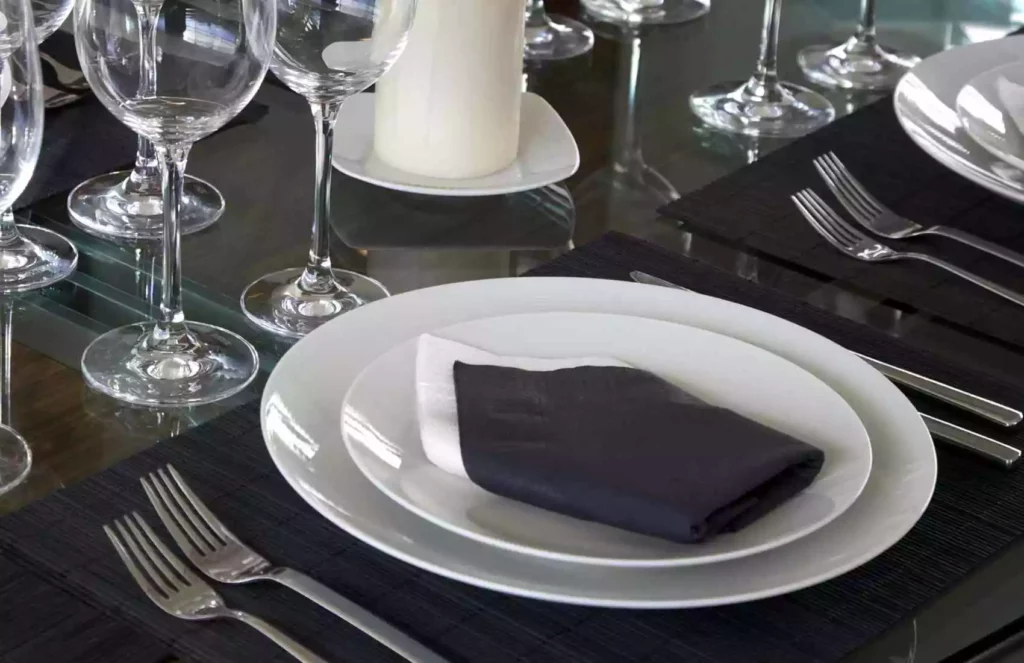
When it comes to setting the table for a meal, there’s more than just aesthetics at play. Each piece of cutlery has a specific purpose, and among the most confusing duo of forks are the salad fork and the dinner fork.
These two forks might seem similar at first glance, but they serve distinct roles in the culinary journey of a meal.
Let’s explore the key differences between them and understand why having the right fork for the right course matters.
1. Size Matters
The most apparent difference between the salad fork and the dinner fork lies in their size. A dinner fork is typically larger, heftier, and more robust. It’s the workhorse of the cutlery world, designed to handle the heartier components of your main course. On the other hand, the salad fork is more delicate and smaller. It’s like the ballet dancer of forks, gracefully maneuvering through the light, delicate textures of a salad.
2. Tines Tell a Tale
Take a closer look at the tines, those pronged ends that do the heavy lifting. The salad fork usually has slightly wider tines compared to the dinner fork. These broader tines are specifically designed to handle the intricacies of a salad. They’re ideal for picking up leafy greens, cherry tomatoes, or other smaller salad ingredients without causing a culinary catastrophe.
3. Shape and Profile
Another distinguishing feature is the overall shape and profile of the forks. The salad fork tends to have a more rounded, slightly broader shape. This design helps you scoop up a combination of salad components in one bite, ensuring you get a mix of flavors and textures. It’s like a mini-shovel, carefully gathering all those delicious ingredients onto your fork.
4. Handle
The handles of dinner forks and salad forks are typically similar in shape, but there are a few key differences.
- Size: Salad forks are typically slightly smaller than dinner forks, and their handles are correspondingly shorter. This makes them easier to maneuver when eating salad greens or other delicate foods.
- Weight: Salad forks are also typically lighter than dinner forks, which can help to reduce fatigue when eating a large salad.
- Curve: The handles of salad forks often have a slight curve, which helps keep the fork in place when resting on the table. This is especially important for salad forks, which are often used with one hand while the other hand is used to hold a plate or bowl.
5. Placement on the Table
The arrangement on the dining table is an important clue to differentiate between these forks. In a formal table setting, you’ll often find the salad fork placed to the left of the dinner fork, closer to the plate.
This positioning isn’t arbitrary; it’s a signal of its intended use for the salad course. It’s like the first act in a culinary symphony, setting the stage for the more substantial courses to follow.
6. Accompanying Companions
Sometimes, the salad fork comes with a tiny companion – a small spoon. This spoon is a salad dressing spoon, and it’s there to help you elegantly drizzle your chosen dressing over the salad.
The presence of this spoon alongside the fork is a clear indicator that you’re in salad territory. It’s a subtle yet valuable addition to ensure your salad experience is delightful from the first bite to the last.
In summary,
The difference between a salad fork and a dinner fork goes beyond just size and appearance. Each fork has a specific role, reflecting the course it’s intended for and the type of food it’s best equipped to handle. The salad fork’s delicacy and thoughtful design cater to the lighter, more nuanced nature of salads, while the dinner fork’s sturdy build tackles heartier main courses with ease.
So, the next time you’re setting the table or dining out at a fine establishment, keep an eye out for these subtle but crucial distinctions between the salad fork and the dinner fork. It’s not just about proper etiquette; it’s about enhancing your dining experience by ensuring you’re using the right fork for the right flavors.
Enjoy your meals, and remember, the right fork is your trusty companion on a culinary adventure!
FAQs
Why is a salad fork smaller than a dinner fork?
A salad fork is smaller than a dinner fork because it’s designed for lighter foods like salads. The smaller size makes it easier to handle and helps you take smaller, delicate bites of veggies and greens. A dinner fork is larger, better for heartier dishes, and can handle bigger bites of food.
Table fork vs. dinner fork, what’s the difference?
The main difference between a table fork and a dinner fork is their size. A dinner fork is larger than a table fork, with longer and more widely spaced tines. This makes it better suited for eating heavier foods, such as steak or chicken. A table fork is smaller and has shorter, more closely spaced tines. This makes it better suited for eating lighter foods, such as salads or vegetables.
Salad fork vs. dinner fork, which to take first?
When dining, it’s customary to start with the salad fork before using the dinner fork. The salad fork is typically placed on the outermost side of the place setting, indicating that it’s intended for the initial course, such as a salad. As you progress through the meal, you’ll use the utensils from the outside in, so the dinner fork would come into play for the main course.
Why does the salad fork have a notch?
The notch on a salad fork serves a practical purpose. It helps you handle slippery or small pieces of salad ingredients, like leaves or cherry tomatoes, more effectively. When you spear these items with the notched end of the fork, it prevents them from sliding off easily, making it easier to lift them to your mouth. The notch is a clever design feature that enhances the functionality of the salad fork for its intended purpose.
What is the mass of a dinner fork?
The mass of a dinner fork can vary based on its material and design. Most standard dinner forks made of stainless steel or a similar material typically weigh around 50 to 100 grams (1.76 to 3.53 ounces). However, this can vary depending on the specific brand, design, and manufacturing choices. If you have a specific dinner fork in mind, you may want to check its specifications or weigh it using a kitchen scale for precise measurement.
What is a European dinner fork?
A European dinner fork, also called a continental dinner fork, is larger and heavier than the typical American dinner fork. It’s part of formal flatware used in European settings, known for its elegant design. The main differences are in size and shape, with a longer and broader, tapered design suitable for multi-course meals and formal dining. It’s placed to the left of the plate in a European-style table setting, with specific forks for different courses, reflecting European dining traditions.
In a formal table setting, which is the only fork placed on the right of the dinner plate?
In a formal table setting, the only fork that is typically placed on the right side of the dinner plate is the dessert fork. It’s positioned above the plate, along with the dessert spoon, to be used for the final course of the meal.
What is the small fork called on the dinner table?
The small fork used for dinner is called the salad fork. It is placed to the left of the dinner fork and is used for eating salad and other light foods. The salad fork is smaller than the dinner fork and has three or four tines. It is also often distinguished from the dinner fork by a notch on the left tine, which is used for cutting lettuce or other tough vegetables.
Can I use a dinner fork as a substitute for a salad fork?
The salad fork may not be present in a casual setting where formal table settings are not used. In this case, you can use the dinner fork for both the salad and the main course. However, it is still considered polite to use a separate fork for each course, if possible.







